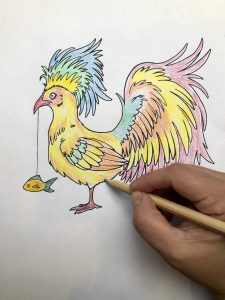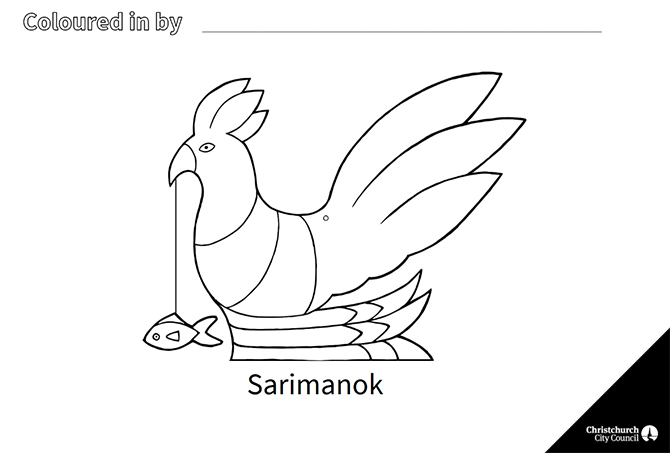
If there’s a symbol that the Maranao people in the Philippines are associated with, it’s the Sarimanok. Sarimanok is an important part of the Maranao people’s cultural heritage, it is invoked in many rituals and it showcases their unique artistic geniuses.
The Maranao tribe is from the Mindanao island in the southern part of the Philippines and even before the arrival of the Spaniards in the country, they had their own culture, language, beliefs and arts. And the Sarimanok, with its beautiful and colourful feathers, is frequently depicted in their artistic, decorative and architectural designs.
The word Sarimanok comes from “Sari” which means a garment of different colours, and “manok”, which means rooster. The figure of sarimanok is normally characterised by its colourful feathers, scroll, leaf and other motifs on its head, and the fish that it carries on its talons or in its beak.
The origin of the sarimanok is not known, but it is widely featured in numerous legends.
According to one legend, once upon a time, there was a prince named Rajah Indarapatra who fell in love with the moon goddess who came to earth every Friday to bathe in a scented well. The prince knew that they couldn’t be together because the moon goddess was not from this world. He fell into deep despair, then one day while he was carving a rooster made of wood, he challenged it to take him to the moon. The rooster, with beautiful feathers, came alive and flew the prince to the moon to be with his beloved. The prince was never seen again.
Another legend says that the Maranaos, who are predominantly Muslim, believed that when the Prophet Muhammad went to the seven heavens, he found the rooster in the first heaven and it was so large that its crest touches the second heaven. Legend says that the crow wakes up all living creatures except man, and it is believed that Judgement day comes when the rooster stops crowing.
However, there is also a legend that states that the existence of sarimanok started pre-Islamic beliefs. According to the Maranaos, the Sarimanok is their totem bird named Itotoro which has a twin-spirit, Inikadowa. When Rajah Indarpatra married a water nymph, they had two sons: one who can be seen and the other, unseen. Seen became the ancestors of the modern-day Maranao people and Unseen is the spirit that they pay tribute to during rituals and rites. These two brothers made a pact that they will always protect each other from bad spirits and they chose the Sarimanok to be their totem bird and through the help of its twin, Inikadowa, it became the link between the seen and the unseen worlds. The fish on the beak of the Sarimanok symbolises the food that the Maranao people offer to the spirit world.
No matter what the origin was, the Sarimanok is highly revered by the Maranaos and has become an integral part of their culture and widely present in their artistic and architectural designs, rituals, dance and festivals. The Maranaos believe that the Sarimanok will bring them good fortune and if the spirits are pleased, they will have a bountiful harvest. And what started as a cultural heritage from the south of the Philippines has already been adopted by the whole country and nowadays, it has become one of its enduring symbols.
Ang mga Alamat ng Sarimanok
Kung mayroong isang simbulo na masasabing tunay na Maranaw ng Pilipinas, ito ay ang Sarimanok. Ang Sarimanok ay mahalaga sa kultura ng mga Maranaw kaya kadalasan ay makikita ito sa mga disenyo nila kung saan naipapamalas nila ang kanilang natatangi at kakaibang galing sa larangan ng singing. Ang Sarimanok ay ginagamit din sa maraming katutubong ritwal ng mga Maranaw
Ang mga Maranaw ay galing sa Mindanao, sa katimugan ng Pilipinas. Bago pa man dumating ang mga Kastila sa bansa, mayroon na silang sariling kultura, lengguahe, paniniwala at sining. At ang Sarimanok, na puno ng makukulay na pakpak ay madalas na makikita sa kanilang mga disenyo sa sining, dekorasyon at maging sa arkitektura.
Ang salitang Sarimanok ay mula sa salitang “Sari” o damit na kadalasan ay makukulay at “manok” na ang ibig sabihin ay manok. Ang sarimanok ay may makukulay o magarbo na mga pakpak at ang ulo nito ay may mga disenyo ng scroll, dahon, at iba’t-iba pang motifs. Sa bibig o kuko nito ay may hawak siyang isda.
Kung saan nagsimula ang sarimanok ay hindi tiyak ngunit maraming alamat ang bumabalot dito.
Sabi sa isang alamat, noong unang panahon, mayroong isang prinsipeng nagngangalang Rajah Indapatra na umibig sa isang dyosa mula sa buwan. Ang dyosang ito ay bumababa sa mundo tuwing Biyernes upang maligo sa mahalimuyak na balon. Batid ng prinsipe na hindi sila maaaring magkatuluyan sapagkat magkaiba sila ng mundo. Nalungkot ang prinsipe kaya isang araw, hinamon niya ang ibon na nilililok niya sa kahoy na dalhin siya sa buwan. Biglang nabuhay ang kahoy na ibon at inilipad niya ang prinsipe sa buwan upang makasama ang kanyang minamahal. Magmula noon, hindi na muling nakita pa ang prinsipe.
Ayon sa isa pang alamat ng mga Maranaw, na karamihan ay mga Muslim, noong umakyat ang Propetang si Muhammad sa pitong kalangitan, nakita nya ang manok sa unang langit at sa sobrang laki nito, ang tuktok nito ay abot hanggang sa ikalawang langit. Sabi din ng alamat na tuwing tumitilaok ang tandang, ginigising nito ang lahat ng nilalang maliban sa tao. Naniniwala sila na dumating na ang Araw ng Paghuhukom kapag ang tandang ay tumigil na sa pagtilaok.
Subalit, mayroon ding isang alamat na nagsimula bago pa mandin dumating ang Islam sa lugar nila. Sabi ng mga Maranaw, ang sarimanok ay ang kanilang totem na ibon na si Itotoro na mayroong kakambal na si Inikadowa. Noong ikinasal sina Rajah Indaparata at isang nimpa, nagkaroon sila ng dalawang anak : ang nakikita at ang hindi nakikita. Ang Nakikita ay ang ninuno ng mga Maranao ngayon at ang Di Nakikita ay ang mga espiritu na syang binibigyan ng alay tuwing may mga ritwal. Ang magkapatid ay nagkaroon ng kasunduan na aalaagan nila ang isa't-isa laban sa mga masasamang espiritu at ang napili nilang totem ay ang Sarimanok. At sa tulong ng kanyang kakambal na si Inikadowa, sya ang naging tulay sa pagitan ng Nakikita at ang Di Nakikita na mundo. Ang isda na makikia sa tuka ng Sarimanok ay sinisimbolo nito ang pagkain na inaalay ng mga Maranao sa mundo ng mga espiritu.
Para sa mga Maranaw, kahit saan man nagsimula ang sarimanok, ito ay mahalaga sa kanilang kultura at lubos nilang ginagalang . Ito ay makikita sa kanilang mga sining, arkitektura, ritwal, sayaw at mga pagdiriwang. Sila ay naniniwalang ito ay magbibigay ng kasaganahan sa kanilang buhay at magiging maganda ang kanilang ani kung matutuwa ang mga espiritu. At ang Sarimanok na simbulo at yaman ng kultura na nagmula sa katimugan ng Pilipinas ay unti-unti na ring nagiging simbulo ng buong Pilipinas.
Challenges: Can you make a beautiful Sarimanok?
Colouring-in

Materials needed:
- Colouring-in print out
- Coloured pencils or crayons
Instructions:
- Print out this page and colours its feathers with bright colours
Sarimanok – cut and paste

Materials needed:
- Template print out
- Tracing paper
- White Cardboard
- Black pen
- Scissors
- Decorative edge scissors
- Coloured papers
- Paper Glue
Instructions:
- Using a tracing paper, trace the pattern markings on to a cardboard
- Cut out the bird with the fish.
- Cut the feather shapes using decorative edge scissors for each colour
- Apply glue to the feathers and stick them to the bird shape. Work from the crest towards the beak and on the body, start from the back and work to the front.
More
- Browse our catalogue to know more at the Philippines
- Read more myths and legends from New Zealand and around the world






Add a comment to: The Legends of the Sarimanok